A High-Precision Transfer of Time and RF Frequency via the Fiber-Optic Link Based on Secure Encryption
Abstract
:1. Introduction
2. Methods
2.1. Basic Principle of Safety Optical Fiber Time Transfer Equipment
2.2. Basic Principle of Encryption Method
3. Experiment
3.1. Experiment and Analysis of Single Safety Optical Fiber Timing Equipment
3.2. Experimental Test
3.3. Result and Discussion
4. Cascade Experiment
4.1. Basic Principle of Ring Network Test
4.2. Result and Discussion
5. Conclusions
Author Contributions
Funding
Institutional Review Board Statement
Informed Consent Statement
Data Availability Statement
Conflicts of Interest
References
- Campbell, S.L.; Hutson, R.B.; Marti, G.E.; Goban, A.; Oppong, N.D.; McNally, R.L.; Sonderhouse, L.; Robinson, J.M.; Zhang, W.; Bloom, B.J.; et al. A Fermi-degenerate three-dimensional optical lattice clock. Science 2017, 358, 90–94. [Google Scholar] [CrossRef] [PubMed] [Green Version]
- Takano, T.; Takamoto, M.; Ushijima, I.; Ohmae, N.; Akatsuka, T.; Yamaguchi, A.; Kuroishi, Y.; Munekane, H.; Miyahara, Y.K.H.M.B.; Katori, H. Geopotential measurements with synchronously linked optical lattice clocks. Nat. Photonics 2016, 10, 662–666. [Google Scholar] [CrossRef]
- Kolkowitz, S.; Pikovski, I.; Langellier, N.; Lukin, M.D.; Walsworth, R.L.; Ye, J. Gravitational wave detection with optical lattice atomic clocks. Phys. Rev. D 2016, 94, 124043. [Google Scholar] [CrossRef] [Green Version]
- McGrew, W.F.; Zhang, X.; Fasano, R.J.; Schäffer, S.A.; Beloy, K.; Nicolodi, D.; Brown, R.; Hinkley, N.; Milani, G.; Schioppo, M.; et al. Atomic clock performance enabling geodesy below the centimetre level. Nature 2018, 564, 87–90. [Google Scholar] [CrossRef] [PubMed] [Green Version]
- Krehlik, P.; Sliwczyński, L.; Buczek, L.; KolOdziej, J.; Lipiński, M. Ultrastable long-distance fibre-optic time transfer: Active compensation over a wide range of delays. Metrologia 2015, 52, 82–88. [Google Scholar] [CrossRef]
- Śliwczyński, Ł.; Krehlik, P.; Czubla, A.; Buczek, Ł.; Lipinski, M. Dissemination of time and RF frequency via a stabilized fibre optic link over a distance of 420 km. Metrologia 2013, 50, 133. [Google Scholar] [CrossRef]
- Ebenhag, S.C.; Jaldehag, K.; Jarlemark, P.; Hedekvist, P.O.; Emardson, R.; Löthberg, P. Time transfer using an asynchronous computer network: Results from a 500 km baseline experiment. In Proceedings of the 39th Annual Precise Time and Time Interval Meeting, Long Beach, CA, USA, 27–29 November 2007; Volume 11, pp. 27–29. [Google Scholar]
- Zhang, H.; Dong, S.W.; Yuan, H.B.; Wu, W.J. Analysis of the performance of SDR TWSTFT. J. Time Freq. 2007, 42, 284. [Google Scholar]
- Wang, B.; Gao, C.; Chen, W.L.; Miao, J.; Wang, L.J. Precise and continuous time and frequency synchronisation at the 5×10−19 accuracy level. Sci. Rep. 2012, 2, 556. [Google Scholar] [CrossRef]
- Chen, F.X.; Zhao, K.; Zhou, X.; Liu, T.; Zhang, S.G. High-precision long-haul fiber-optic time transfer between multi stations. Chin. J. Phys. 2017, 66, 33–41. [Google Scholar]
- Liu, J.; Deng, X.; Zhang, X.; Zang, Q.; Wang, D.; Jiao, D.D.; Gao, J.; Wang, D.; Zhou, Q.; Liu, T.; et al. Progress of fiber-based optical frequency transfer in NTSC. J. Time Freq. 2021, 4, 231–243. [Google Scholar]
- Ebenhag, S.C.; Hedekvist, P.O.; Jarlemark, P.; Emardson, R.; Jaldehag, K.; Rieck, C.; Löthberg, P. Measurements and error sources in time transfer using asynchronous fiber network. IEEE Trans. Instrum. Meas. 2010, 59, 1918–1924. [Google Scholar] [CrossRef]
- Cui, L.; Yuan, M.; Li, Z.; He, J. Implementation of fault-tolerance WSN time synchronization algorithm for coal mine. J. PLA Univ. Sci. Technol. 2015, 23, 284–292. [Google Scholar]
- Olivier, L.; Amale, K.; Paul, E.P.; Daniele, R.; Joseph, A.; Christian, C.; Anne, A.K.; Giorigo, S. Simultaneous remote transfer of accurate timing and optical frequency over a public fiber network. Appl. Phys. B 2013, 110, 3–6. [Google Scholar]
- Gao, C.; Wang, B.; Bai, Y.; Miao, J.; Zhu, J.; Zhu, X.; Li, T.C.; Wang, L.J. Fiber Based Time and Frequency Synchronization System. Sci. Technol. Herald 2014, 32, 41–46. [Google Scholar]
- Chen, F.X.; Zhao, K.; Li, B.; Liu, B.; Guo, X.X.; Kong, W.C.; Chen, G.C.; Guo, B.L.; Liu, T.; Zhang, S.G. High-precision dual-wavelength Time Transfer via a 1085 km telecommunication fiber link. Chin. J. Phys. 2021, 70, 69–78. [Google Scholar]
- Chen, Z.F.; Zuo, F.X.; Hu, L.; Jin, Y.; Chen, J.P.; Wu, G.L. Time Synchronization System Based on Bidirectional Time-Division Multiplexing Transmission over Single Fiber with Same Wavelength. Chin. J. Lasers 2021, 48, 6. [Google Scholar]
- Qi, Z.; Quan, H.; Zhao, K.; Zhang, X.; Xue, W.; Chen, F.; Zhao, W.; Liu, T.; Dong, R.; Zhang, S. High-precision time-frequency signal simultaneous transfer system via a wdm-based fiber link. Photonics 2021, 8, 325. [Google Scholar]
- Wu, G.L.; Chen, J.P. Ultra-long haul high-precison fiber-optic two way time transfer. Sci. Technol. Herald 2016, 34, 99. [Google Scholar]
- Chen, D.; Xu, J.N.; Li, Z.Z.; Jiang, S.; He, H.Y.; Liang, Y.F. Advancement in Time Synchronization Technology Using Bi-Contrast Methods in Optical Fiber. Laser Optoelectron. Prog. 2020, 57, 9. [Google Scholar]
- Wang, T.F.; Zhang, H.F.; Xu, S. Security analysis and countermeasures for software implementation of SM2 algorithm. Appl. Res. Comput. 2021, 38, 2811–2815. [Google Scholar]
- Huang, H.; Wu, G.; Hu, L.; Chen, J. Influence of temperature on the precision of bidirectional TDM based fiber-optic time transfer. Acta Opt. Sin. 2015, 35, 105–111. [Google Scholar] [CrossRef]

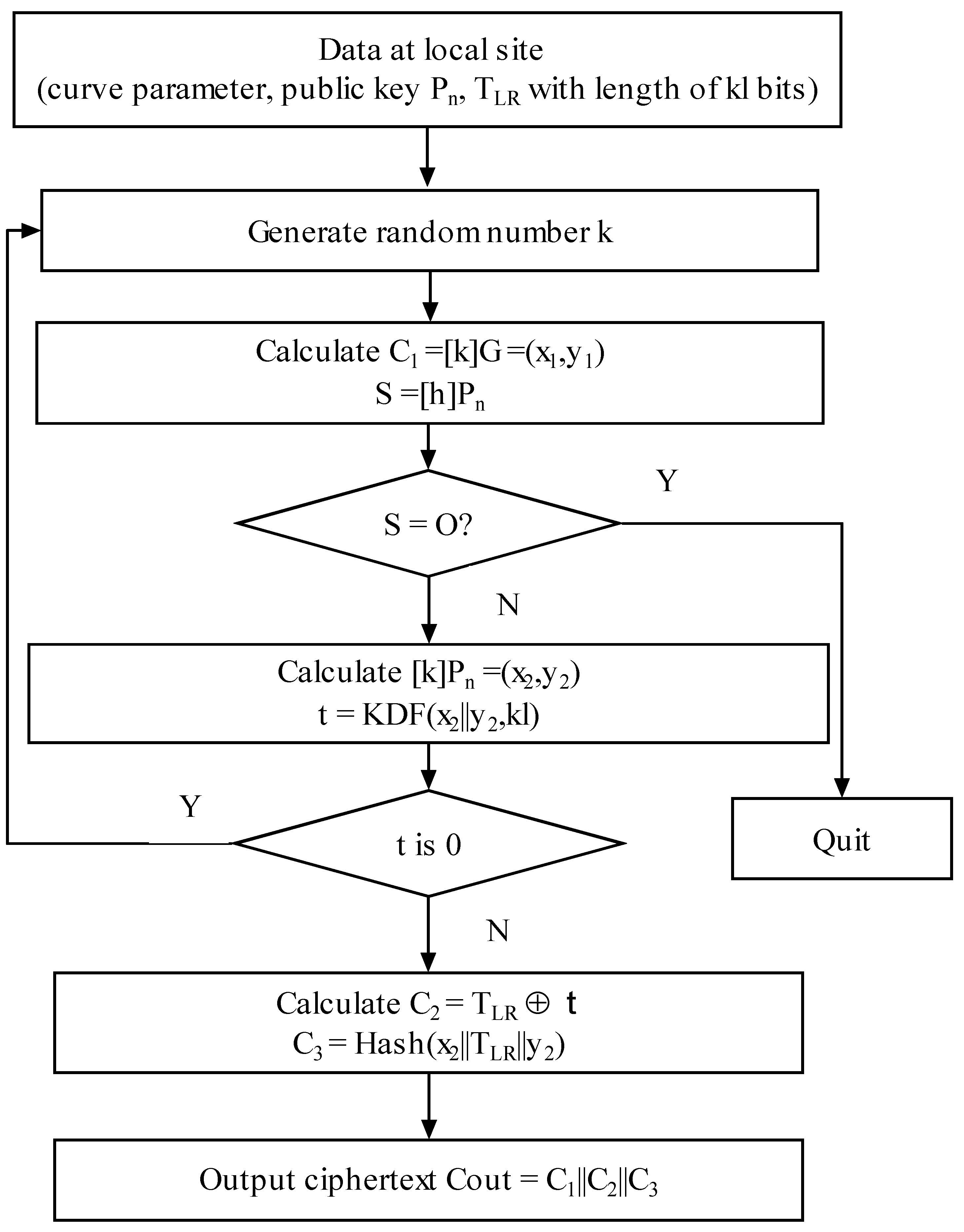
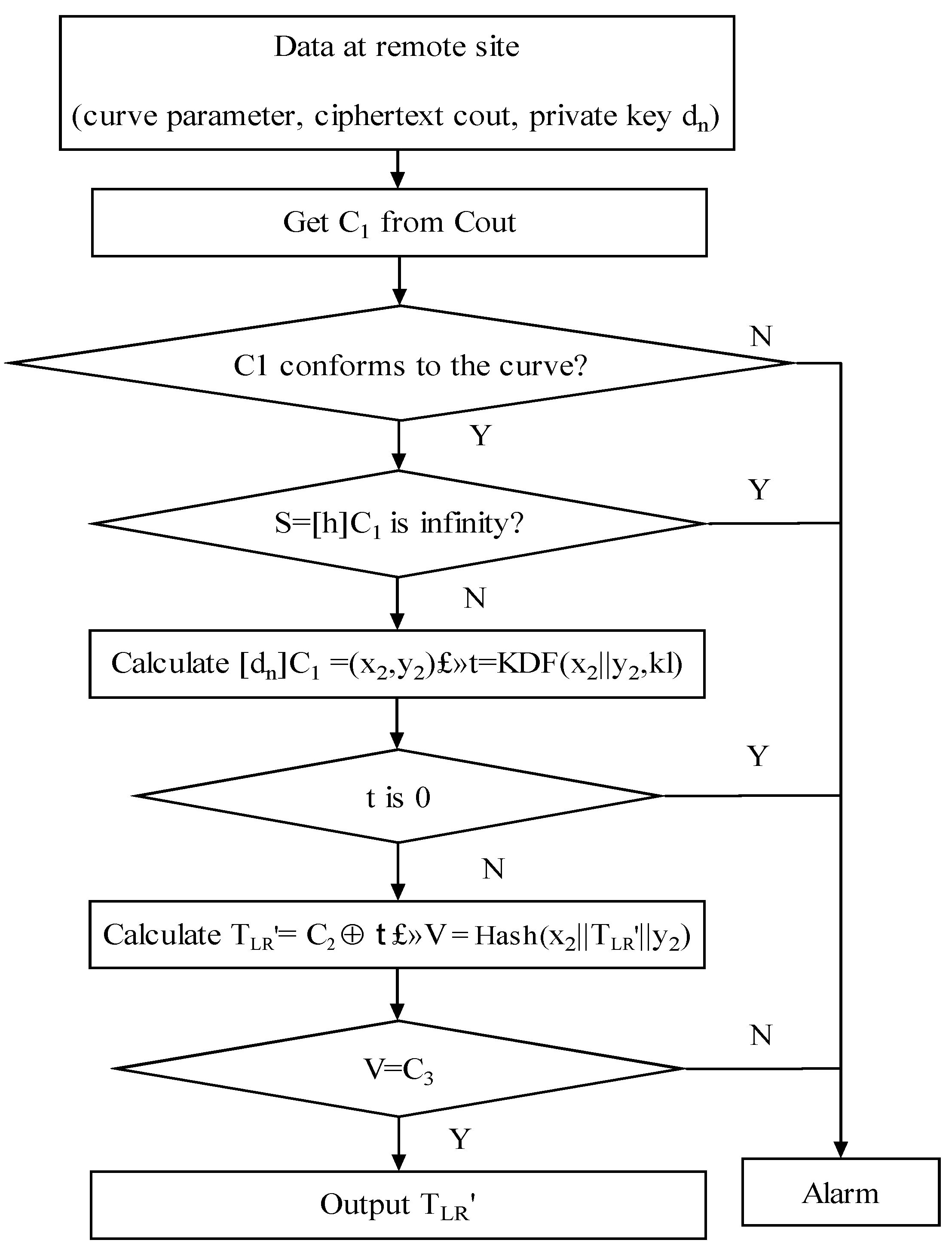

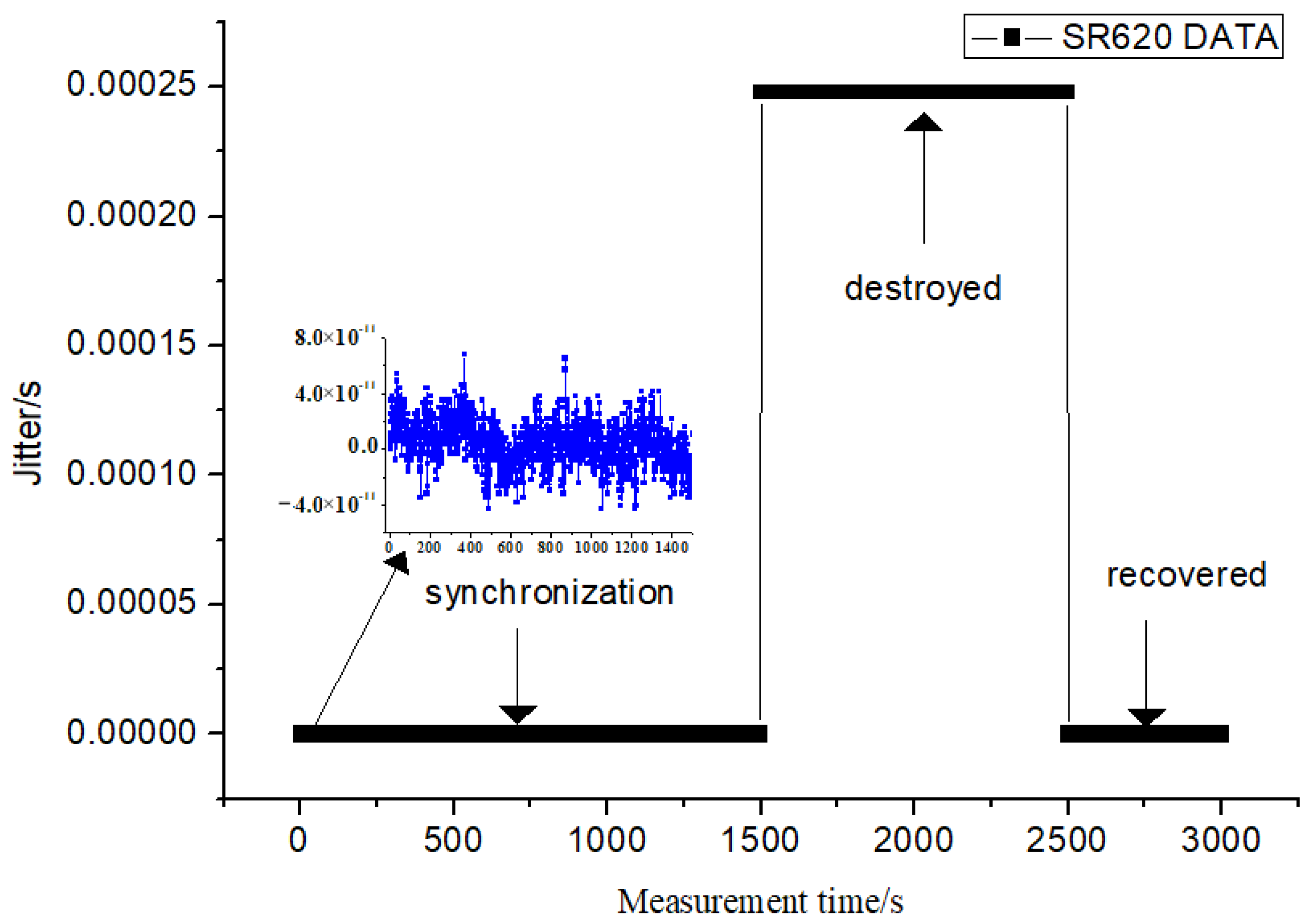
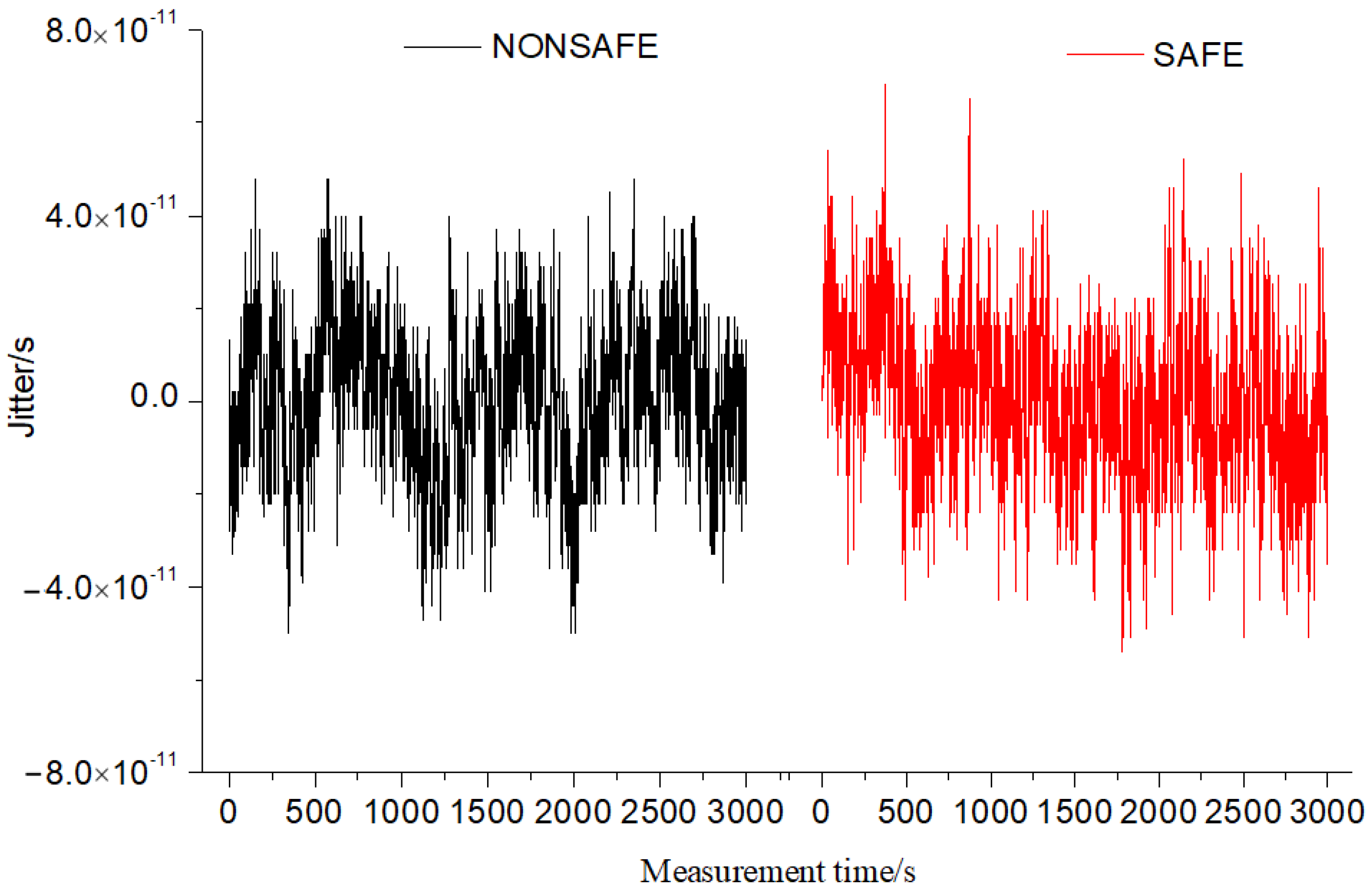
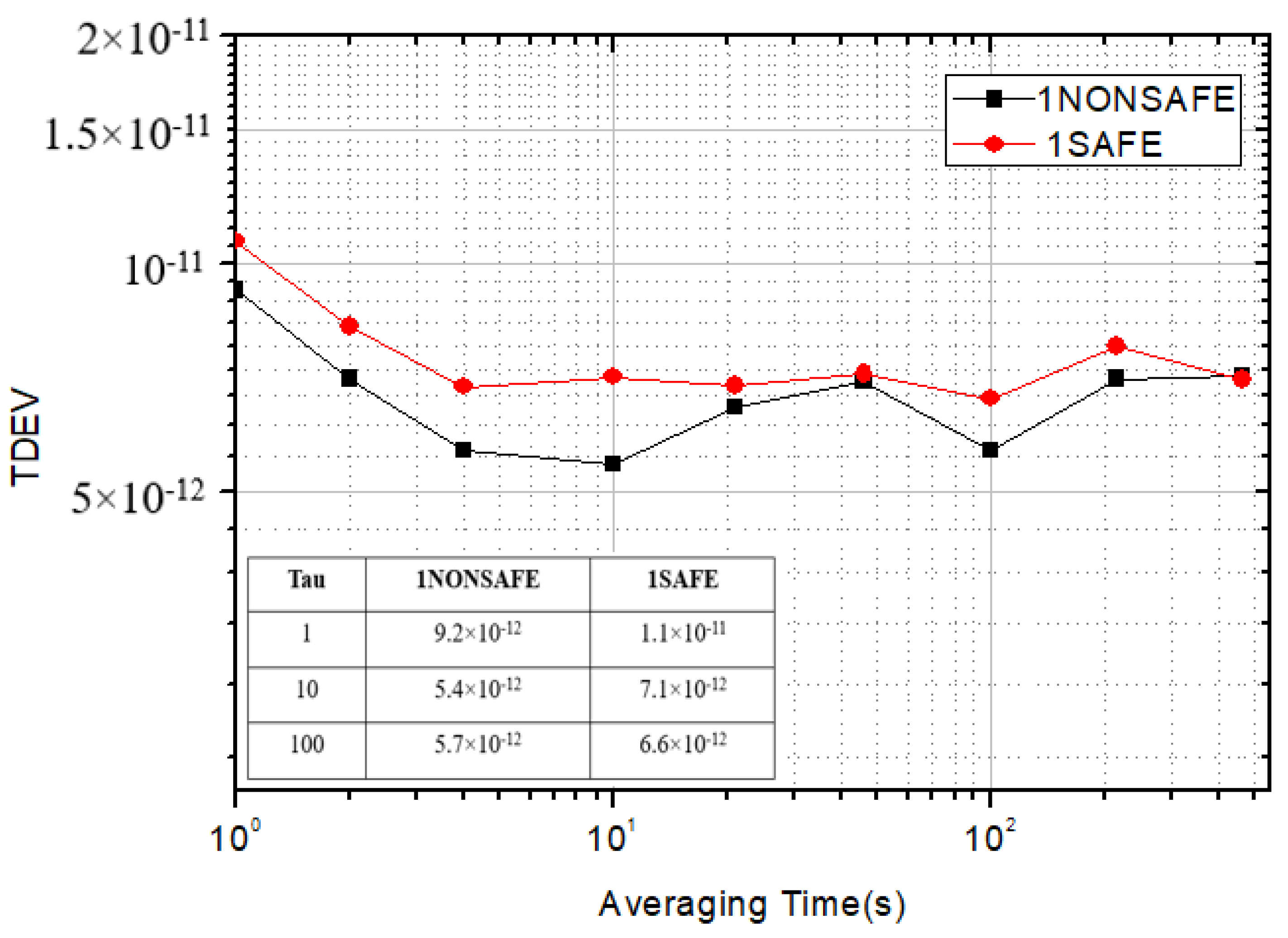
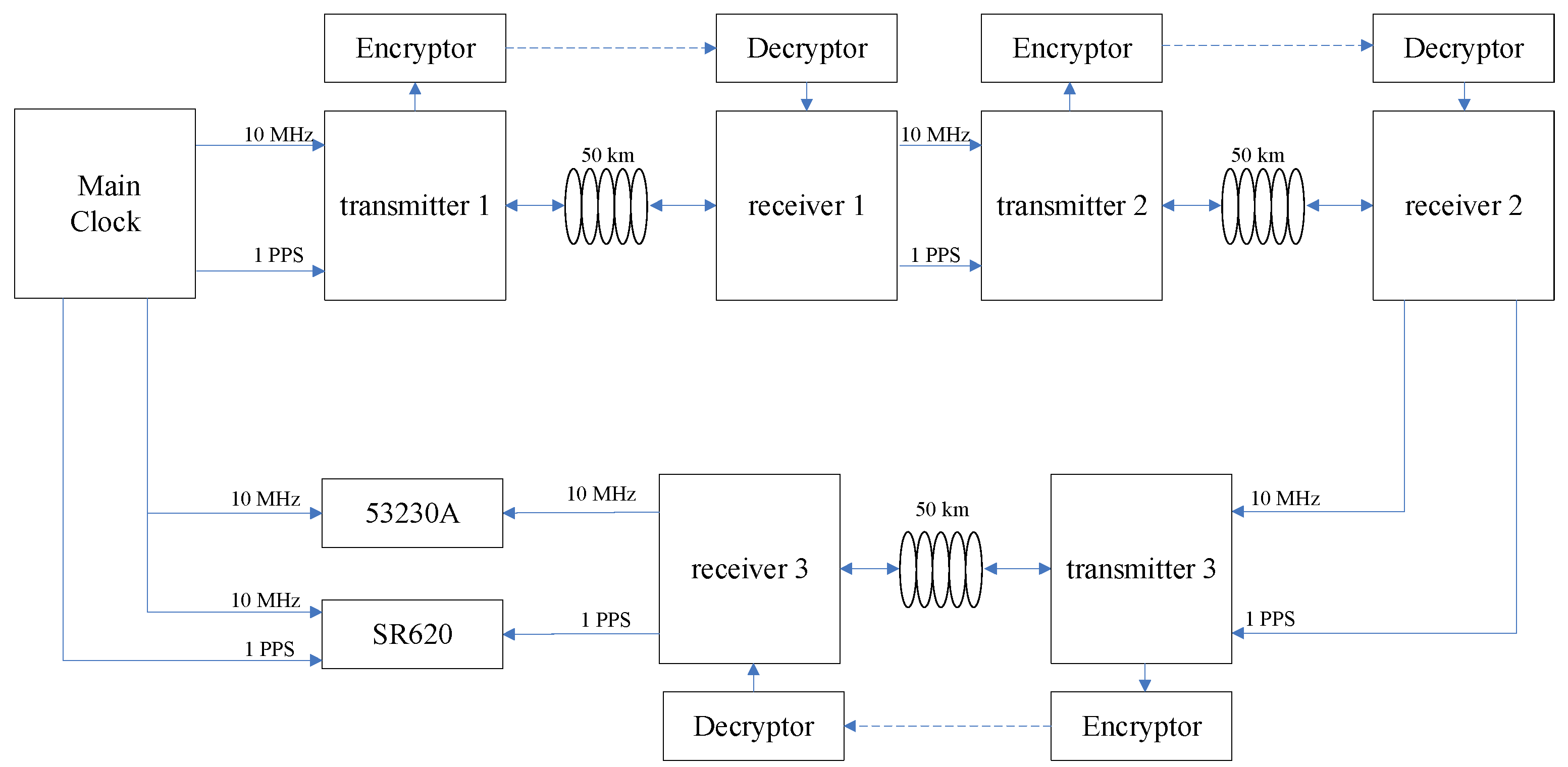
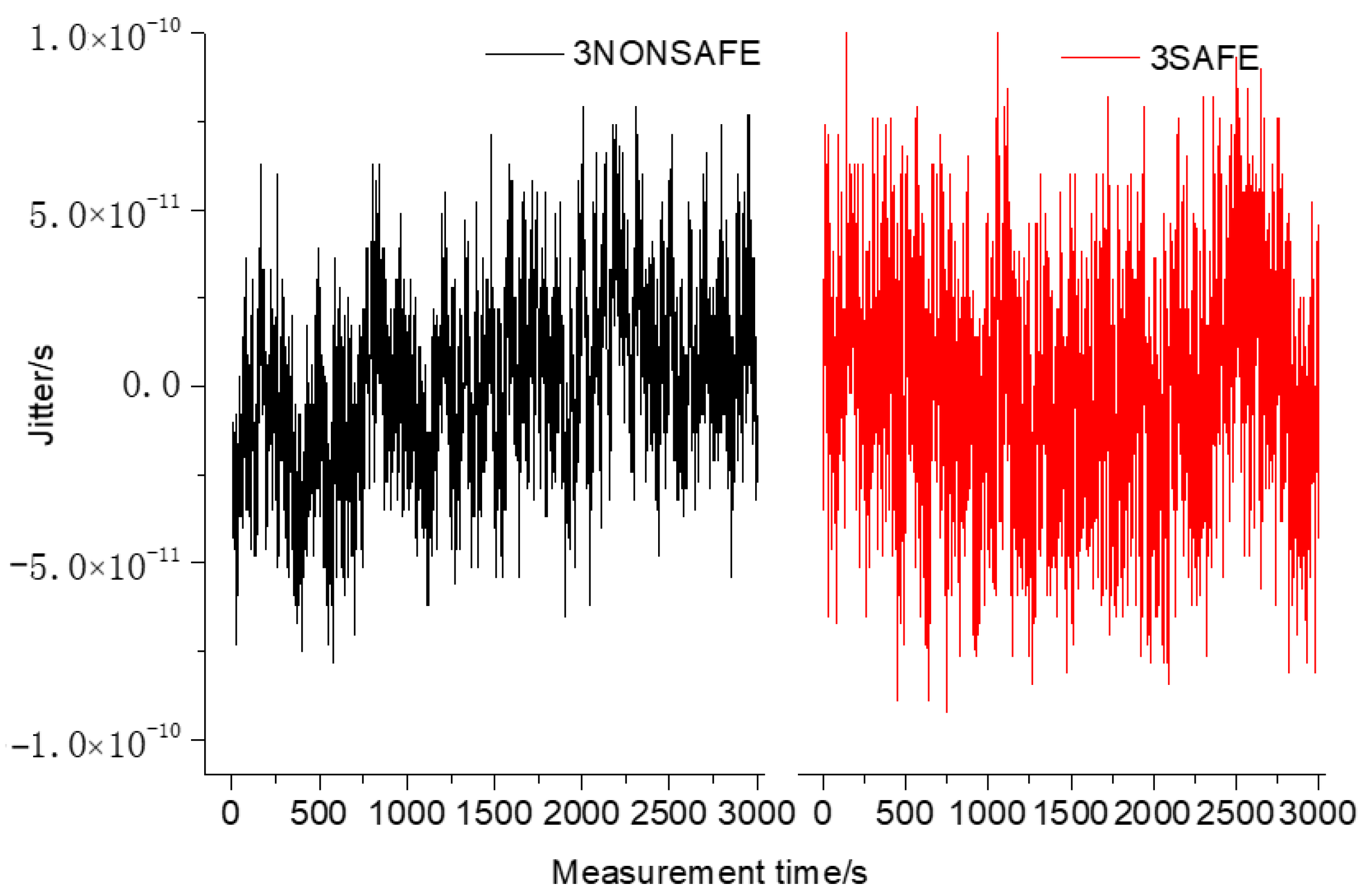
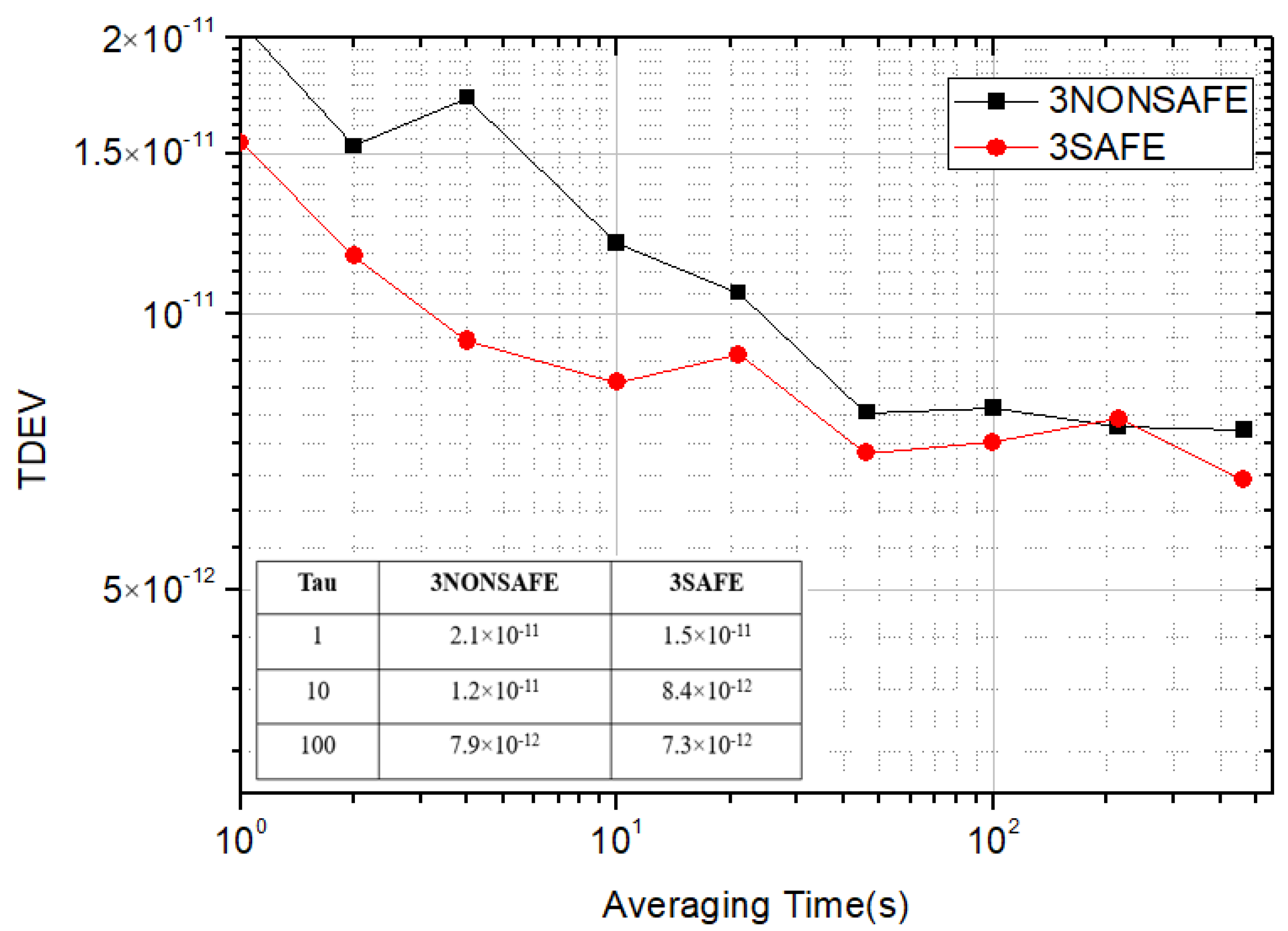
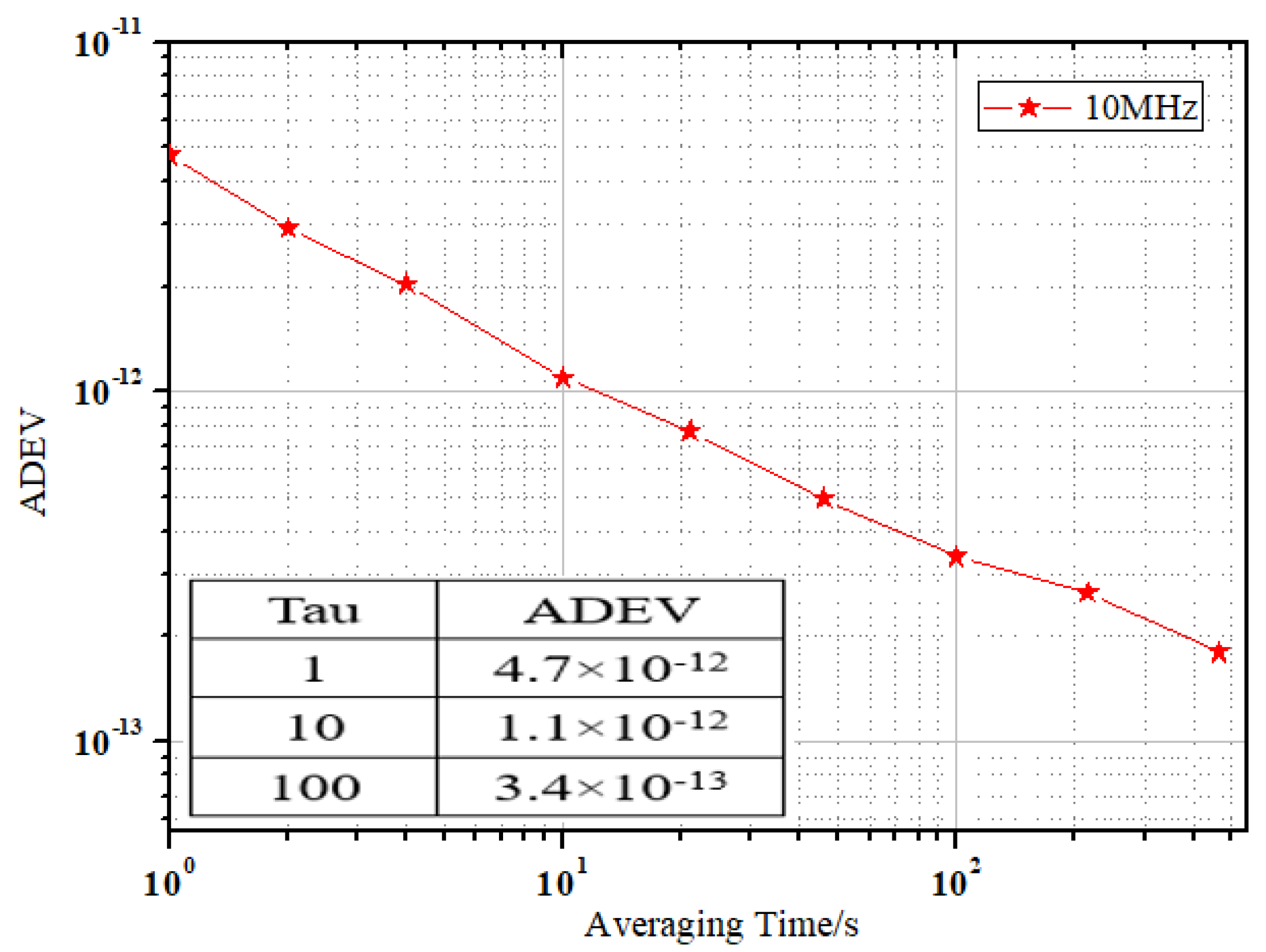

| Symmetric Key Length | RSA Key Length | SM2 Key Length | Period of Confidentiality |
|---|---|---|---|
| 80 | 1024 | 160 | 2010 |
| 128 | 3072 | 256 | 2040 |
| 256 | 15,360 | 512 | 2120 |
| Data before Encryption | 249,746,186 |
| Public key Pn | x = 435B39CC_A8F3B508_C1488AFC_67BE491A_ 0F7BA07E_581A0E48_49A5CF70_628A7E0A y = 75DDBA78_F15FEECB_4C7895E2_C1CDF5FE_ 01DEBB2C_DBADF453_99CCF77B_BA076A42 |
| Random k | 4C62EEFD_6ECFC2B9_5B92FD6C_3D957514_ 8AFA1742_5546D490_18E5388D_49DD7B4F |
| Ciphertext C_out | 04245c26fb68b1ddddb12c4b6bf9f2b6d5fe60a383b0d18d1c4144abf17f6252e 776cb9264c2a7e88e52b19903fdc47378f605e36811f5c07423a24b84400f01b8 325a09edd6078149e61d7bc237a17eb718c546e2a2ef00e8146885749c58bce8b870ceb43988c4546a |
| Private key dn | 1649AB77_A00637BD_5E2EFE28_3FBF3535_ 34AA7F7C_B89463F2_08DDBC29_20BB0DA0 |
| After decryption ASCII | 32 34 39 37 34 36 31 38 39 32 34 39 37 34 36 31 38 39 |
| Decrypted plaintext | 249,746,186 |
| Stability (TDEV) | 1 Equipment | 2 Cascades | 3 Cascades |
|---|---|---|---|
| No encryption | 9.21 × 10−12 | 14.1 × 10−12 | 15.4 × 10−12 |
| Encryption | 10.7 × 10−12 | 15.7 × 10−12 | 20.8 × 10−12 |
Publisher’s Note: MDPI stays neutral with regard to jurisdictional claims in published maps and institutional affiliations. |
© 2022 by the authors. Licensee MDPI, Basel, Switzerland. This article is an open access article distributed under the terms and conditions of the Creative Commons Attribution (CC BY) license (https://creativecommons.org/licenses/by/4.0/).
Share and Cite
Guo, X.; Qiu, Y.; Liu, B.; Kong, W.; Liu, T.; Dong, R.; Zhang, S. A High-Precision Transfer of Time and RF Frequency via the Fiber-Optic Link Based on Secure Encryption. Appl. Sci. 2022, 12, 6643. https://doi.org/10.3390/app12136643
Guo X, Qiu Y, Liu B, Kong W, Liu T, Dong R, Zhang S. A High-Precision Transfer of Time and RF Frequency via the Fiber-Optic Link Based on Secure Encryption. Applied Sciences. 2022; 12(13):6643. https://doi.org/10.3390/app12136643
Chicago/Turabian StyleGuo, Xinxing, Yanfeng Qiu, Bo Liu, Weicheng Kong, Tao Liu, Ruifang Dong, and Shougang Zhang. 2022. "A High-Precision Transfer of Time and RF Frequency via the Fiber-Optic Link Based on Secure Encryption" Applied Sciences 12, no. 13: 6643. https://doi.org/10.3390/app12136643






